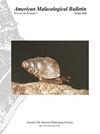Unraveling Cryptic Morphological Diversity in a Marine Snail Species Complex Using Nuclear Genomic Data
IF 0.4
4区 生物学
Q4 MARINE & FRESHWATER BIOLOGY
引用次数: 1
Abstract
Abstract: Conus lividus (Hwass in Bruguière, 1792) and Conus sanguinolentus (Quoy and Gaimard, 1834) are closely related Indo-West Pacific cone snails that have largely overlapping distributions. Previous population genetic analyses of these species found that some individuals that were identified as C. lividus possessed mitochondrial gene sequences that were similar or in some cases identical to those of C. sanguinolentus. While these species tend to be easily distinguished based on shell color patterns, it is possible that some individuals of C. sanguinolentus were misidentified as C. lividus. The result though could also be due to introgression of the mitochondrial genome of C. sanguinolentus into C. lividus. We used a ddRAD approach to obtain sequences of short fragments of more than 7,000 nuclear genomic loci to examine patterns of variation and evaluate these explanations. Results showed that the two parental species are genetically differentiated at nuclear loci and all putative hybrids were unambiguously assigned to C. sanguinolentus based on shared patterns of variation. These results demonstrate that variation in shell color patterns of C. sanguinolentus overlaps with that of C. lividus, and extend the distribution of C. sanguinolentus into the Hawaiian Archipelago. Additional analyses of patterns of genetic variation among populations of the two species revealed that while C. lividus shows no genetic population structure, the population of C. sanguinolentus from Hawaii is genetically differentiated from populations elsewhere as found in prior analyses based on mitochondrial sequence data.利用核基因组数据揭示海螺物种复合体的隐蔽形态多样性
摘要:生活锥螺(Hwass in Bruguière,1792)和血锥螺(Quy和Gaimard,1834)是印度-西太平洋锥螺的亲缘关系密切,分布基本重叠。先前对这些物种的群体遗传学分析发现,一些被鉴定为C.lividus的个体具有与C.sanginolentus相似或在某些情况下相同的线粒体基因序列。虽然这些物种往往很容易根据外壳的颜色模式进行区分,但血血红蛛的一些个体可能被误认为生活血红蛛。然而,这一结果也可能是由于血红蛛的线粒体基因组渗入了生活蛛。我们使用ddRAD方法获得了7000多个核基因组基因座的短片段序列,以检查变异模式并评估这些解释。结果表明,这两个亲本物种在核基因座上是遗传分化的,所有假定的杂交种都根据共同的变异模式明确地归属于血红蛛。这些结果表明,血红蛛外壳颜色模式的变化与李维杜的重叠,并将血红蛛的分布扩展到夏威夷群岛。对这两个物种种群之间遗传变异模式的进一步分析表明,虽然利维杜没有显示出遗传种群结构,但来自夏威夷的血血红蛛种群与其他地方的种群在遗传上存在差异,这是在先前基于线粒体序列数据的分析中发现的。
本文章由计算机程序翻译,如有差异,请以英文原文为准。
求助全文
约1分钟内获得全文
求助全文
来源期刊
CiteScore
1.00
自引率
40.00%
发文量
1
审稿时长
>12 weeks
期刊介绍:
The American Malacological Bulletin serves as an outlet for reporting notable contributions in malacological research. Manuscripts concerning any aspect of original, unpublished research,important short reports, and detailed reviews dealing with molluscs will be considered for publication. Recent issues have included AMS symposia, independent papers, research notes,and book reviews. All published research articles in this journal have undergone rigorous peer review, based on initial editor screening and anonymous reviewing by independent expertreferees. AMS symposium papers have undergone peer review by symposium organizer, symposium participants, and independent referees.

 求助内容:
求助内容: 应助结果提醒方式:
应助结果提醒方式:


